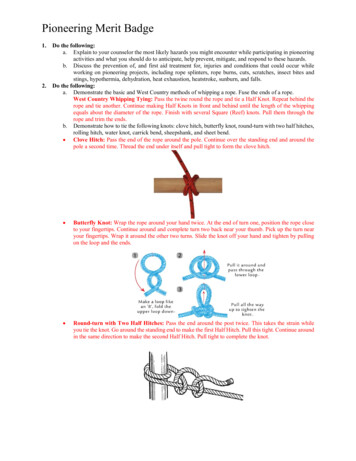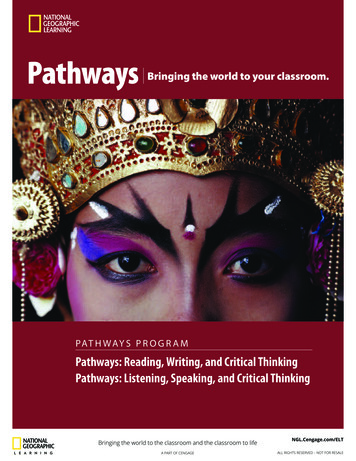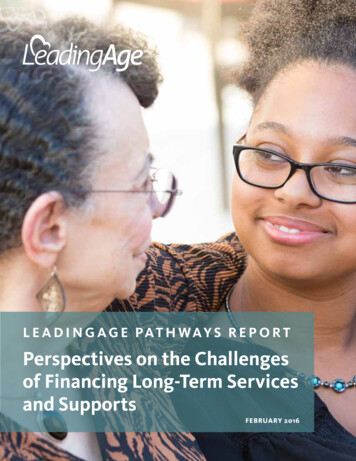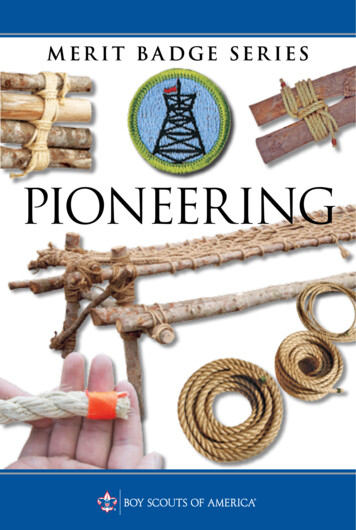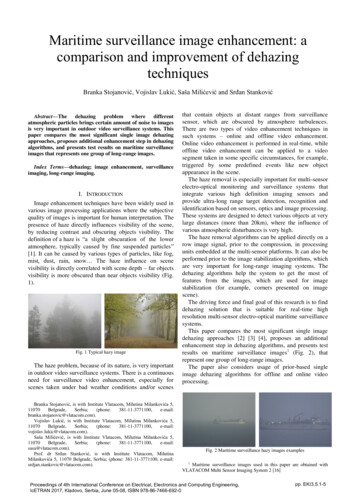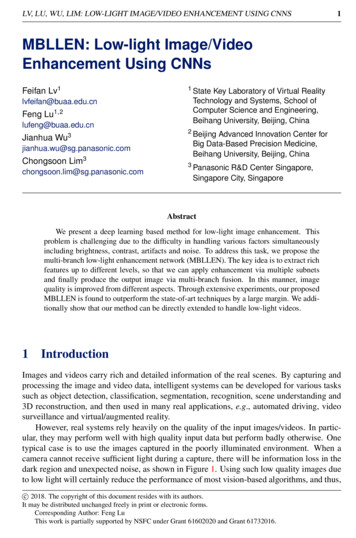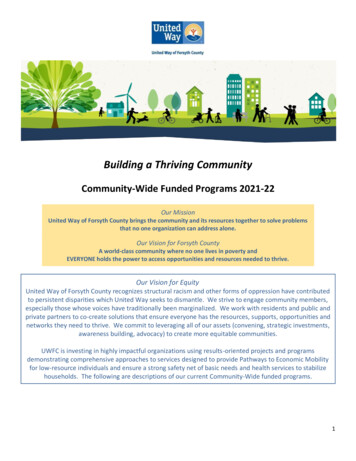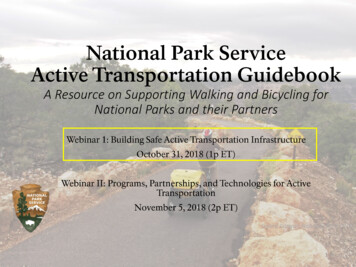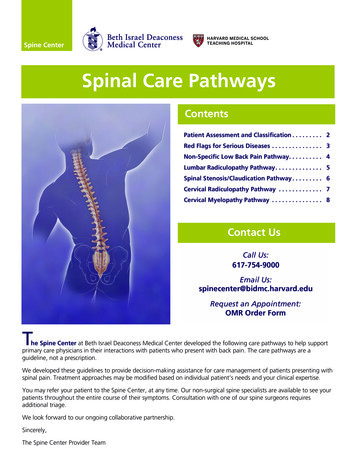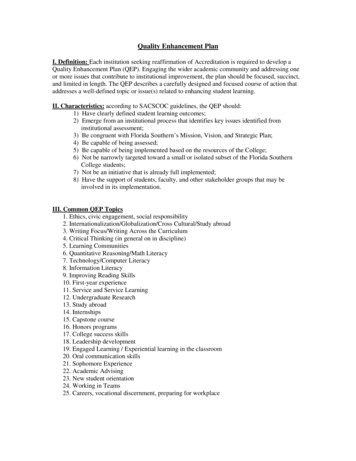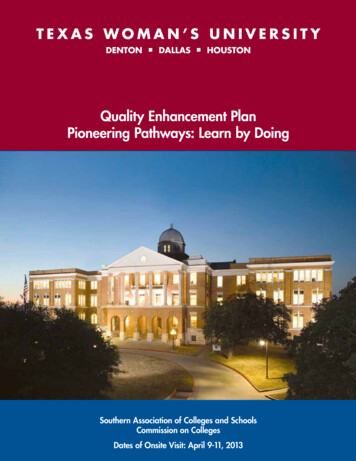
Transcription
TEXAS WOMAN’S UNIVERSITYDENTON DALLAS HOUSTONQuality Enhancement PlanPioneering Pathways: Learn by DoingSouthern Association of Colleges and SchoolsCommission on CollegesDates of Onsite Visit: April 9-11, 2013
Executive SummaryTWU’s Quality Enhancement Plan, Pioneering Pathways:Learn by Doing, focuses on enhancement of student learningthrough student engagement in experiential learning. The purposeof the QEP is to equip students with knowledge, experience, andreadiness to lead personally and professionally fulfilling lives.Developed with broad-based input from faculty, staff, students, andalumni, the QEP provides a systematic, institutionally-supportedplan for supporting and assessing experiential learning at TWU.Student initiatives, faculty development, and internal and externalpartnerships are foundational elements of the QEP.Learning by doing and applying theory to practice is consideredcrucial for student success in an ever-changing, increasinglyconnected, and global world. Graduates face complex challengeswhich require skills in critical thinking and problem solving, agreater awareness and appreciation for multiple perspectives, andcollaboration and teamwork with diverse individuals to achievecommon goals. Experiential learning provides an ideal means forequipping students with these skills and is an effective strategy forincreasing student engagement among at-risk students.Experiential learning at TWU may take many forms andincludes service learning and civic engagement, internships, cocurricular collaboration, scholarship, and creative activities. QEPimplementation is guided by the following goals: Develop and expand experiential learning opportunitiesfocused on the success of students to live, work, and lead in adiverse and complex world. Integrate and align university infrastructures and resourcesthat support collaborative and co-curricular experientiallearning opportunities and student success initiatives. Cultivate and strengthen educational, civic, and businesspartnerships that increase opportunities for experientiallearning, interdisciplinary and collaborative scholarship, andcreative activity.The QEP will enhance student learning by increasing opportunitiesfor students’ participation in experiential activities and projectswithin their academic disciplines. Guided by best practices andgrounded in experiential learning theory, the QEP will createa culture of experiential learning at TWU, and revitalize theUniversity’s dedication to bridge theory with practice and to learn bydoing.Quality Enhancement PlaniPioneering Pathways: Learn by Doing
ContentsExecutive Summary. iInstitutional Context. 1Institutional Need, Topic Selection, and Alignment. 7Literature Review & Best Practices. 27Leadership Structure & Implementation. 35Assessment Plan. 47Budget Justification. 61Conclusion. 65References. 66Appendix A.71Appendix B.73Appendix C. 74Appendix D.79Appendix E.86Appendix F.88Appendix G.89Appendix H.90Appendix I.93Appendix J.95Appendix K.96Learn byDoingTEXAS WOMAN’S UNIVERSITYDENTON DALLAS HOUSTON
Institutional ContextTWU has enjoyed many successes over the last ten years,including unprecedented enrollment growth, new facilities onall campuses, elevated admission standards, and thriving graduateprograms; however, the university faces significant challenges withretention, graduation rates, and the high number of first-generationand at-risk students. These issues draw attention to questionsabout the extent to which students are engaged in their disciplines,invested in their learning, and prepared for success in life and work.Thus, TWU has selected a QEP topic focused on student learningto incorporate real world experiences and foster a commitmentto life-long learning and service. Experiential learning will serveas one cornerstone, among other strategies, to improve studentlearning and success by proactively engaging students in theirdisciplines both within and outside the University.OverviewTexas Woman’s University offers high quality education in the liberalarts and sciences and professional studies, and also conductsresearch to enhance the progress and welfare of the people ofTexas, the nation, and the world in a time of rapid technologicaland social change. TWU is a Doctoral Research public university,primarily for women, offering baccalaureate, master’s, and doctoraldegrees. TWU is the largest university primarily for women in theUnited States.Pioneering Pathways: Learn by Doing1Quality Enhancement Plan
Texas Woman’s UniversityThe University is committed to creating a campus environmentwhich empowers students of different ages, social status, andethnicity to obtain the essential knowledge, skills, independence,and confidence needed to enhance their prospects of success.Students are provided numerous opportunities to express theirpoints of view, to test ideas, to make decisions, and to succeed asleaders. TWU serves as a source of knowledge and as a repositoryof information about women and their contributions to the historyand advancement of the State of Texas, the nation, and the world.Health-related studies and graduate education are integral to themission of TWU. TWU has for many years been a regional andnational leader in offering nursing and health science programs.These programs have evolved, as knowledge and technology in thehealth sciences have changed, to meet diverse health care needs.TWU continues as the largest provider of nursing and allied healthprofessionals in the state and one of the largest in the nation.TWU is a pioneer in preparing women to pursue careers in suchfields as allied health, librarianship, nursing, nutrition, social work,and teaching. Undergraduate and selected graduate programsare offered to increase the participation of women in fields inwhich women have been historically under-represented. Doctoralprograms are offered in allied health sciences, education, familysciences, kinesiology, library science, nursing, and selected areasof the arts, humanities, and natural and social sciences.The University includes the College of Arts and Sciences (includingthe School of the Arts and the School of Management), the Collegeof Professional Education (including the School of Library andInformation Studies), the College of Health Sciences (including theSchools of Physical Therapy and Occupational Therapy), and theCollege of Nursing. The Graduate School administers graduateprograms in each of these schools and colleges. Now in its twelfthdecade, the University has become a major public university servedby approximately 400 full-time faculty members and more than15,000 students enrolled in Fall 2012. The curriculum, which led tothe award of baccalaureate degrees for the first time in 1915, nowaccommodates studies that lead to doctoral degrees in each of thecolleges of the University.Quality Enhancement Plan2“Our region anticipates tremendousgrowth and needs more workforceready graduates. Real worldexperience and the ability to usecritical thinking in the workplaceis a repeated request we get fromour business members. Combiningcoursework with hands-on programswill benefit our local businesses.”Angela FarleyVice PresidentPublic Policy and Education,Dallas Regional ChamberPioneering Pathways: Learn by Doing
Learn byDoingInstitutional ContextWhite 43.8%African American 21.6%Hispanic 23.3%Asian American & Pacific Islander8.8%American Indian & Alaskan Native1.4%International1.4%Other0.8%Figure 1. The percent distribution of undergraduate students among ethnic groups at TWU, Fall2012.Student ProfileTWU’s enrollment has grown consistently and rapidly in the lastdecade. In Fall 2012, 15,168 students were enrolled at TWU. Eightynine percent of enrolled students are female, and 38% stem from anunder-represented minority group. Undergraduates represent 62%of total enrollment, 44% of which are Hispanic or African American(Figure 1) and 12% of which are First Time in College (FTIC).Thirty-five percent of undergraduates enrolled in Fall 2012 are firstgeneration, meaning neither parent attended college. Approximately50% of undergraduates enrolled in Fall 2012 had at least one parentwho attended but did not complete college. Master’s studentsconstitute 31% of TWU’s student population, and 7% are doctoralstudents.Figure 2 and Figure 3 demonstrate the magnitude of enrollmentgrowth at TWU. In particular, minority enrollment has outpacedgrowth in other areas for the entire student population (Figure2) and within undergraduates (Figure 3). The TWU Office ofInstitutional Research and Data Management predicts that by 2014Hispanic students will constitute 25% of the undergraduate studentpopulation, making TWU eligible to apply for designation as aHispanic-Serving Institution (HSI).Pioneering Pathways: Learn by Doing3Quality Enhancement Plan
Texas Woman’s University3600900032008000Non-white Students24002000700060005000A160040001200 H3000800400White StudentsW28002000SINO20031000200420052006W WhiteA African AmericanN American Indian/Alaskan Native200720082009201020112012HHispanicSAsian American/Pacific IslanderIInternationalOOtherFigure 2. The change in total student enrollment by ethnicity from 2003 to 2012.WNon-white Students20004500400017503500150030001250 A250010002000750White Students22501500H5001000250 SINO2003500200420052006W WhiteA African AmericanN American Indian/Alaskan Native200720082009201020112012HHispanicSAsian American/Pacific IslanderIInternationalOOtherFigure 3. The change in undergraduate student enrollment by ethnicity from 2003 to 2012.Quality Enhancement Plan4Pioneering Pathways: Learn by Doing
Learn byDoingInstitutional ContextOne-year retention rates for FTIC students are 65% for all studentsand 66% for minority students. The FTIC 6-year graduation rateis 48% for all students, and 44% for minority students. The 6-yeargraduation rate for transfer students is 63%. The graduation ratesfor masters students are: 53% in 2 years; 73% in 4 years; and 76%in 6 years. The doctoral graduation rate is: 51% in 4 years; 64% insix years; and 75% in 10 years.Campus and CentersTWU, with its main campus in Denton and health science centersin Dallas and Houston, serves not only the north central region,but also the entire state of Texas. The T. Boone Pickens Instituteof Health Sciences - Dallas Center, located in the vicinity of UTSouthwestern Medical Center and Parkland Hospital, offersacademic programs in a variety of health science fields to servethis major area of Texas. The Houston Center, located in the TexasMedical Center, provides an excellent setting for students of healthscience and related fields. The graduate programs in health careadministration, nursing, nutrition and dietetics, occupational therapy,and physical therapy offered in Houston are in the vanguard ofgraduate-level, professional health education in the Southwest.TWU graduates more health care professionals than any otherhigher education institution in Texas. The Houston Center isunique to the greater metropolitan Houston and Galveston areaeducating health care professionals at the baccalaureate, master’s,and doctoral levels in nursing, occupational and physical therapy,nutrition and food science, and health care administration.Historical PerspectiveEstablished in 1901 by an act of the 27th Legislature as the GirlsIndustrial College, the institution began classes in 1903. In 1905the Legislature changed the name to the College of Industrial Arts.The college grew in academic excellence, in size and scope, andin reputation. The rising academic qualifications of the faculty,the building of a substantial library and research and instructionalfacilities, and the increasing demand for graduate education forwomen led to the establishment of graduate studies at the collegein 1930.Pioneering Pathways: Learn by Doing5Quality Enhancement Plan
Texas Woman’s UniversityIn 1934 the name of the institution was changed to the TexasState College for Women to describe more accurately the scopeof the school. Doctoral degrees were first awarded in 1953. Since1957 the name has been Texas Woman’s University, indicativeof its status as a major institution of higher learning offeringbaccalaureate, master’s and doctoral degrees. As is indicatedby the name, TWU has historically been a single-sex institution.However, in 1972 the University began accepting qualified men intothe Institute of Health Sciences and the Graduate School. Effectivein 1994, all areas of the University were opened to qualified maleand female applicants.Of particular relevance to TWU’s QEP, TWU founders recognizedthe importance of experiential learning and adopted the Universitymotto, “We learn to do by doing.” Stemming from a quote fromComenius (considered the father of modern education) andrecommended by Helen Stoddard, one of TWU’s first Regents, themotto captures the unique focus of a TWU education so well that itwas engraved on the University’s first building (Bridges, 2001, p. 7).The QEP represents a renewed commitment to TWU’s historicalfocus on the connection between experience and learning.Quality Enhancement Plan6Pioneering Pathways: Learn by Doing
Institutional Need, Topic Selection,and AlignmentLearning by doing and applying theory to practice is consideredcrucial for student success in an ever-changing, increasinglyconnected, and global world. Graduates face complex challengesthat require skills in critical thinking and problem solving, a greaterawareness and appreciation for multiple perspectives, andcollaboration and teamwork with diverse individuals to achievecommon goals. Experiential learning provides an ideal meansfor equipping students with these skills. TWU’s QEP will assist inmeeting challenges identified by educators, employers, and recentcollege graduates to provide students with greater opportunities todevelop skills necessary for personal and professional success.The QEP will also assist in increasing meaningful interactions andlong-lasting relationships between TWU students and communityorganizations - public, private, and non-profit.Institutional NeedAs illustrated in the student profile, TWU serves a large populationof females and underrepresented minority groups. Researchindicates minority and first-generation college students face uniqueand different barriers to academic success (Blankenship, 2010;Dolan, 2008; Kirby, White, & Aruguete, 2007; McKay &Estrella, 2008; Murphy, Gaughan, Hume, & Moore, 2010). Scholarsalso suggest women and minorities face similar challenges foracademic study and careers in science, technology, engineering,and math (STEM) fields (Espinosa, 2011; Ong, Wright, Espinsosa, &Orfield, 2011; Reyes, 2011).Given TWU’s student population and desire to improve persistenceand graduation rates among underrepresented minority groups,a QEP addressing both the unique challenges of the studentpopulation and the need to better prepare students for personalsuccess and workforce readiness was warranted. Experientiallearning is a key element in enhancing student engagement,and increased student engagement favorably impacts retentionand graduation rates. Student engagement through experientiallearning has been identified as a supporting factor for persistenceto graduation, advanced study, and improved workforce readiness(Eyler, 2009; Hart Research, 2006, 2008, 2010; Kelly, 2011; Lee,2007). Experiential learning through internships, service learningand civic engagement, and experiential research has also provenimpactful in increasing persistence rates, graduation rates, andpursuit of advanced study in underrepresented minority groups(Dolan, 2008; Espinosa, 2011; Kelly, 2011; Stocks, 2011). EngagingPioneering Pathways: Learn by Doing7Quality Enhancement Plan
Texas Woman’s Universityfemale students in experiential research has shown favorableresults in transitioning women and underrepresented minoritygroups into the STEM fields (Espinosa, 2011; Higgins et al., 2011;Johnson, 2011; Jones, Barlow, & Villarejo, 2010; McDaniel, 2011;Ong et al., 2011; Reyes, 2011; Stocks, 2011).Pioneering Pathways: Learn by Doing offers new and enhancedopportunities for experiential learning at TWU. This QEP allowsTWU to better prepare students for entry into the workforce and tostrategically focus on increasing persistence and graduation ratesthrough enhanced student engagement.Timeline and Development of TopicTWU’s QEP selection process has been broad-based, involvingnumerous faculty, staff, and students. The QEP topic selectionand planning effort was conducted in three phases: informationsharing and awareness, topic selection, and plan development.During development, the QEP evolved from a wide array of topics,to service learning, and then to a broader emphasis on experientiallearning.Phase 1: Information Sharing and AwarenessIn Fall 2010, Dr. Barbara Lerner, Associate Provost forUndergraduate Studies & Academic Partnerships and TWUSACS liaison, conducted two informational sessions about TWU’sreaffirmation effort and requirements for the QEP. These sessionswere open to the university community and were intended toraise awareness for the reaffirmation process and to initiate ideageneration for a QEP topic.Quality Enhancement Plan8Pioneering Pathways: Learn by Doing
Learn byDoingInstitutional Need, Topic Selection, and AlignmentIn Spring 2011, a QEP Committee of faculty, staff, and studentswas formed to guide and manage the QEP development andselection process. Also during this timeframe, students enrolledin an Applied Business Environment course prepared a marketingmodel to generate awareness for the QEP and conducted asurvey of faculty, staff, students, and alumni to identify potentialQEP topic ideas. Students used various promotional avenuesincluding town hall meetings, flyer distribution on all campuses,social media, Blackboard announcements, the QEP website,announcements on television monitors in the Student Union, directemail communication to alumni, and direct email to all TWU faculty,staff, and students. The students consulted university stakeholders,including the Faculty Senate and Student Government, to increaseawareness for the QEP and to encourage survey responses.Guided by survey results and after conducting a qualitative thematicanalysis of more than 1100 survey responses, the QEP Committeeidentified 12 potential concept areas: Pioneering Pathways: Learn by DoingCritical thinkingImproved writing skillsImproved faculty training to improve student learningPeer-to-peer mentoring for incoming freshmenUtilization of technology to enhance course contentInformation literacyEnhanced research techniques and integration of researchacross the curriculumGlobal perspectivesVolunteerism and service learningImproved communication skillsEnhanced and increased internship opportunitiesClass sizes.9Quality Enhancement Plan
Texas Woman’s UniversityThe QEP Committee initiated a call for pre-proposals on the 12concept areas in April 2011. The call also invited pre-proposals ontopics beyond the 12 previously identified. Criteria for pre-proposalsincluded: Ability to enhance student learning in a well-defined, focusedtopic Ability to addressed a defined need for students Centered on a concept that would excite and motivate TWUconstituents, including faculty, students, staff, and communitymembers High probability of effective implementation over a five-yearperiod, given institutional human and financial resources Specific and measurable student learning outcomes (SLOs) A clear connection to the mission and strategic direction ofTWU.Eleven pre-proposals were submitted to the QEP Committee forreview in June 2011.Phase 2: Topic SelectionIn June 2011, the QEP Committee shifted focus from topic ideageneration to topic development and selection. Using the preproposal criteria, institutional needs, and initial research on QEPsfrom other institutions, the committee evaluated 11 pre-proposalsand recommended 6 for further development and expansion.Members of the university community were invited to form writingteams to expand the 6 pre-proposals. Individuals volunteered toserve, and self-selected the writing team for which they wouldserve. A summary of the six pre-proposals is provided in Table 1.In July 2011, the QEP Committee held a workshop for the writingteams to assist the teams in securing institutional data and in writingstudent learning outcomes. Many writing teams solicited input fromthe university community on their respective topic via direct emailsand online surveys. The 6 pre-proposals were submitted for reviewto the committee in September 2011.As part of its review process, the committee solicited input from theuniversity community via the QEP website and an online surveyin October 2011. The university community was provided with theExecutive Summary and a full proposal for each of the six topics.The QEP committee also produced a video on each proposaltopic and utilized the campus newspaper, university website,social media, campus banners, word of mouth, and focus groupsto generate awareness and secure input on the topics. More than1200 faculty, staff, and students responded to the online survey.In November 2011, the QEP Committee hosted an open forum oneach campus to acquire additional input.Quality Enhancement Plan10Pioneering Pathways: Learn by Doing
Learn byDoingInstitutional Need, Topic Selection, and AlignmentTable 1. QEP Six Finalist Pre-Proposal TopicsPre-Proposal TitleSummaryCommunicate IT!(Later called iCommunicate:The Power of EffectiveCommunication)Creation of a new undergraduate infrastructure incorporatingsuccessful technology use and written and oral communicationskills throughout the undergraduate curriculum while preparingstudents for their professional life beyond TWU.ICUC: Inspiring CulturalUnderstanding throughCreativityIntegration of multicultural elements across the curriculumusing a module that consists of best practices and creativepedagogical techniques. Sought to strengthen institutionalcommitment to create culturally competent students andemployees.iPioneers Managing a Worldof Information: BuildingSkills for Scholarship andLearningEmpower students to locate, evaluate, and use informationeffectively and form a basis for lifelong learning.Enhancing Student Successand Career Sustainabilitythrough Quality ResearchSkillsEnhance the student experience at TWU by providing studentswith the research skills needed for academic success as wellas preparation for job sustainability and/or graduate schoolsuccess.Bringing Education toLife: Service Learning andStudent Success at TWU(Later called iServe:Learning by Doing)Sustainable LiteracyPioneering Pathways: Learn by DoingMake for-credit service learning a defining focus and a signatureactivity at TWU and provide more institutional support for facultyand more service learning opportunities for students.Integrate sustainable principles and values into all aspectsof education and learning, thereby giving TWU students theknowledge needed to address the social, economic, legal,human health and wellness, P-16 academics, cultural andenvironmental problems facing humanity in this millennium.A multi-disciplinary approach for integration into a coherentprogram of study was proposed using undergraduate researchand civic engagement tools to increase student learning.11Quality Enhancement Plan
Texas Woman’s UniversityThe Committee reviewed survey results and input providedthrough focus groups and open forums in conjunction with acustom rubric to evaluate proposals. Regardless of the topic, eachproposal included a focus on preparing students for personal andprofessional success.Two topics were strongly supported by the online survey resultsand by the QEP Committee: iServe: Learning by Doing andiCommunicate: The Power of Effective Communication. InDecember 2011, the QEP Committee highlighted the advantagesand challenges of each topic and ultimately recommendediServe, a QEP centered on service learning. The Committeealso recommended integration of elements included in otherproposals that were aligned with service learning. The Committeeacknowledged the challenge of measuring student learningoutcomes for service learning, but felt strongly that service learningshould be pursued given its potential to enhance student learningand address the institutional needs of TWU. The Committeerecommended further refinement and development of the servicelearning topic. The QEP topic of service learning was approved bythe Chancellor and President in late December 2011 and by theBoard of Regents in February 2012. The topic identification processis highlighted and summarized in Table 2.Phase 3: Plan Development and Pilot ProjectIn late February 2012, the QEP Committee transitioned from topicdevelopment and selection to a planning and advisory committee.The committee began refining and developing the service learningtopic. Guided by input from the university community, the committeebroadened the topic to experiential learning to ensure inclusion ofall types of applied learning and to most appropriately representthe varied disciplines at TWU. In April 2012, TWU sought externalexpertise and guidance in developing the final plan. Dr. VeroniqueTran, Director of the University of Houston’s Learning throughDiscovery QEP, conducted a two-day workshop centered onplan development, awareness generation, implementation, andassessment.The committee met throughout Summer 2012 and entitled TWU’sQEP project Pioneering Pathways: Learn by Doing. During this timeframe, the Provost requested applications from members of theuniversity community to serve as Interim Director of the QEP. In lateJuly 2012, an Interim Director for the QEP was selected from thepool of applicants. The Interim Director and committee held monthlymeetings in Fall 2012 to finalize the plan, goals, and studentlearning outcomes, implementation and assessment strategies, andtactics for generating awareness for the QEP. The QEP planningand advisory committee also developed the QEP Pilot ProjectQuality Enhancement Plan12Pioneering Pathways: Learn by Doing
Learn byDoingInstitutional Need, Topic Selection, and AlignmentTable 2. Topic Identification TimelineTime FrameFall 2010March 2011ActionSACS Reaffirmation and QEP Informational SessionsQEP Topic Selection Committee formed with 2 faculty cochairs, 10 additional faculty members, 3 staff members, and 2students (1 undergraduate and 1 graduate)Applied Business Environment students conducted a universitywide awareness campaign and disseminated a survey toacquire topic ideas.April 2011First committee meeting conducted for data analysis of campuswide survey; 12 potential topics identified and a call for 2-pagepre-proposals distributed.June 201111 pre-proposals were reviewed and were reduced to 6 semifinal topics; authors for the white papers were identified andteam members were recruited.July 2011September 2011October 2011November 2011QEP Campus Workshop held for semi-finalist white paperauthors on retrieving institutional data and writing studentlearning outcomes.6 white papers were received with massive exposure to staff,faculty, students, alumnae, and community members. Mediaincluded a videotape, newspaper advertisement, universitywebsite, Facebook, campus banners, word of mouth, and focusgroups.Call for public comment from TWU community (staff, faculty,students, alumnae, and community members) conducted andsurvey placed online for ranking and discussion of the 6 semifinalist topic proposals. Over 1200 interested parties participatedin the online survey.Early November: QEP Topic Selection Forum held on all 3campuses for TWU community feedback on 6 semi-finalistproposals.Late November: Final QEP Topic Selection Committee meetingto determine final topic(s). A topic centered on service learningwas selected.Pioneering Pathways: Learn by Doing13Quality Enhancement Plan
Texas Woman’s UniversityTime FrameDecember 2011ActionEarly December: QEP Committee Co-Chairs met with SACSLeadership Team to present topic recommendations.Late December: Service learning topic approved by Chancellorand President.February 2012QEP topic approved by Board of Regents.QEP Committee transitions to plan development and advisorycommittee.April 2012QEP Workshop conducted by Dr. Veroniqu
which require skills in critical thinking and problem solving, a greater awareness and appreciation for multiple perspectives, and . Pioneering Pathways: Learn by Doing 1 Quality Enhancement Plan . national leader in offering nursing and health science programs. These programs have evolved, as knowledge and technology in the .
